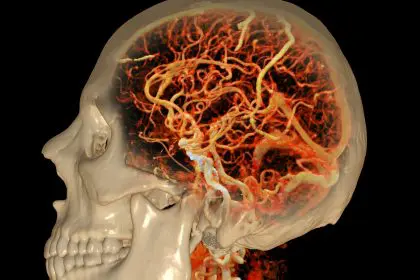That sudden pain in your abdomen might just be indigestion—or it could be something far more serious. When it comes to appendicitis, knowing the difference could save your life. This potentially dangerous condition requires prompt medical attention, making it crucial to recognize its distinctive warning signs.
The appendix—that small, finger-shaped pouch attached to your large intestine—may seem insignificant, but when it becomes inflamed, it can create a genuine medical emergency. While not every stomach ache spells disaster, appendicitis demands immediate medical care to prevent rupture and widespread infection.
For those experiencing unexplained abdominal discomfort, understanding the hallmark symptoms of appendicitis can make all the difference between timely treatment and serious complications. Here’s what you need to know about this common but potentially dangerous condition.
The telltale progression of appendicitis pain
Appendicitis rarely announces itself with sudden, severe pain right from the start. Instead, the discomfort typically follows a distinctive pattern that sets it apart from ordinary digestive issues.
The pain often begins around the navel or middle abdomen, starting as a dull ache that many might dismiss as ordinary indigestion or gas. This initial discomfort can be mild enough that people continue their normal activities, perhaps taking an antacid and expecting relief.
Within hours, however, the pain typically shifts locations—migrating to the lower right abdomen. This movement pattern is one of the most distinctive features of appendicitis. The pain also intensifies during this migration, often becoming sharp, persistent, and focused in the right lower quadrant of the abdomen.
What makes appendicitis particularly concerning is how the pain behaves when you move. Walking, coughing, or even taking deep breaths typically worsens the discomfort. Many people find that they instinctively want to lie still, often with knees drawn up toward the chest, as any movement aggravates the pain.
A critical warning sign appears when pressing on the painful area and then quickly releasing pressure—a phenomenon known as “rebound tenderness.” This action causes significantly more pain upon release than during the initial pressure, indicating inflammation of the peritoneum, the membrane lining the abdominal cavity.
Beyond pain: 5 key symptoms that signal danger
While abdominal pain represents the primary symptom of appendicitis, several accompanying signs help distinguish this serious condition from less concerning digestive problems. These additional symptoms typically develop within 24-48 hours after the pain begins:
- Nausea and vomiting: Unlike typical stomach bugs where vomiting might provide relief, appendicitis nausea typically follows the onset of pain and doesn’t alleviate discomfort. The nausea may be mild or severe, often accompanied by one or more episodes of vomiting, but eating or drinking typically worsens rather than relieves symptoms.
- Loss of appetite: A sudden and complete disinterest in food represents another red flag. Even favorite foods become unappealing, and the thought of eating may intensify nausea. This differs from many other abdominal conditions where appetite might be reduced but not completely absent.
- Low-grade fever: Body temperature typically rises as the body fights the inflammation. While not always dramatic—often between 99-101°F (37.2-38.3°C)—this fever tends to develop after other symptoms have appeared. A rising fever, particularly when combined with worsening abdominal pain, signals escalating inflammation.
- Abdominal swelling: The area around the appendix may become visibly distended or feel tight and hard to the touch. This swelling results from the inflammatory process and potentially from the body’s efforts to “wall off” the infected area.
- Inability to pass gas or have bowel movements: Many people with appendicitis experience constipation or the inability to pass gas, creating a sensation of fullness or blockage. Some might alternatively experience diarrhea, though this occurs less frequently. Either change in bowel habits, when accompanied by the characteristic pain pattern, warrants medical attention.
The ticking clock: Why rapid response matters
Appendicitis progresses on its own timeline, but understanding the typical progression helps explain why medical professionals emphasize urgent care. The condition generally follows a predictable pattern if left untreated.
In the early stages, inflammation causes the appendix to swell and fill with blood, creating the initial pain. As bacteria multiply within the restricted space, pressure builds inside the appendix, further intensifying discomfort and triggering additional symptoms.
Without intervention, the increasing pressure eventually compromises blood flow to the appendix walls. This restricted circulation leads to tissue death, weakening the appendix structure and bringing it closer to rupture.
The critical window for treatment typically spans 36-72 hours from symptom onset until potential rupture, though this timeline varies considerably between individuals. Some appendices rupture faster, while others may smolder for days before reaching critical pressure.
A ruptured appendix releases bacteria into the abdominal cavity, causing peritonitis—a serious infection of the abdominal lining that can spread throughout the body. This complication dramatically increases treatment complexity and recovery time while significantly raising the risk of life-threatening complications.
Modern surgical techniques have dramatically reduced mortality rates from appendicitis, but this positive outcome depends entirely on receiving treatment before rupture occurs. This urgency explains why medical professionals emphasize seeking immediate care for suspected appendicitis rather than adopting a wait-and-see approach.
Mistaken identity: Conditions that mimic appendicitis
Part of what makes appendicitis challenging to identify comes from its ability to resemble other medical conditions. Several health issues can produce similar symptoms, potentially leading to confusion or delayed treatment.
Gastroenteritis, commonly called stomach flu, often tops the list of appendicitis mimics. Both conditions can cause abdominal pain, nausea, vomiting, and fever. However, gastroenteritis typically produces more generalized abdominal discomfort rather than the migrating, localized pain characteristic of appendicitis.
Urinary tract infections, particularly those affecting the right kidney, may cause pain that radiates to the lower right abdomen. The presence of urinary symptoms like burning during urination or increased frequency usually helps distinguish this condition from appendicitis.
For women, gynecological conditions present particular diagnostic challenges. Ovarian cysts, especially if they rupture or twist, can cause sudden, severe right-sided pain similar to appendicitis. Pelvic inflammatory disease and ectopic pregnancy can likewise produce symptoms easily confused with appendicitis.
Inflammatory bowel conditions like Crohn’s disease, particularly when they affect the end of the small intestine near the appendix, may create appendicitis-like symptoms. The chronic, recurring nature of these conditions usually distinguishes them from the acute onset of appendicitis.
These overlapping symptom patterns explain why medical evaluation remains essential for suspected appendicitis. Diagnostic procedures, including physical examination, blood tests, urinalysis, and imaging studies, help differentiate appendicitis from conditions with similar presentations.
Special considerations across age groups
Appendicitis can affect anyone, but its presentation varies considerably across different age groups, making recognition particularly challenging at certain life stages.
Children often struggle to describe their symptoms precisely, making appendicitis detection more difficult. They may complain of stomachaches without being able to localize the pain and might demonstrate discomfort through unusual behaviors like walking hunched over or refusing to move. Parents should watch for a child who avoids jumping or being bounced, as these actions typically exacerbate appendicitis pain.
Teenagers frequently develop classic appendicitis symptoms, making diagnosis relatively straightforward. However, this age group sometimes delays reporting symptoms due to embarrassment, fear of medical procedures, or concerns about missing important events. This hesitation can allow the condition to progress to more dangerous stages before treatment.
Pregnant women face special challenges regarding appendicitis diagnosis. As pregnancy advances, the growing uterus pushes the appendix higher in the abdomen, changing the typical location of pain. This displacement can make the usual right lower quadrant pain less reliable as a diagnostic indicator.
Older adults may experience blunted symptoms, with less pronounced pain and fewer accompanying signs. This muted presentation, combined with communication difficulties in some elderly patients, can lead to delayed diagnosis and higher complication rates in this vulnerable population.
These age-related differences highlight the importance of maintaining a high index of suspicion for appendicitis when evaluating abdominal pain in any age group, with special attention to atypical presentations in the very young, pregnant women, and older adults.
Diagnosis: The path to certainty
When someone arrives at a medical facility with suspected appendicitis, healthcare providers follow a systematic approach to confirm or rule out this condition while checking for possible alternatives.
The evaluation typically begins with a detailed medical history, focusing on the pain’s onset, progression, and location, along with accompanying symptoms. This history helps establish the characteristic timeline and symptom pattern associated with appendicitis.
Physical examination provides crucial information, with particular attention to the abdomen. The provider checks for tenderness, especially in the right lower quadrant, along with signs of peritoneal irritation like rebound tenderness and guarding (involuntary muscle tension protecting the painful area).
Blood tests look for elevated white blood cell counts, indicating infection or inflammation. While not specific to appendicitis, these elevations support the diagnosis when combined with typical symptoms and physical findings.
Urinalysis helps rule out urinary tract conditions that might mimic appendicitis while also checking for signs that inflammation near the ureter might be affecting urine composition.
Imaging studies provide the most definitive pre-surgical information. Ultrasound offers a radiation-free first option, particularly valuable for children and pregnant women. CT scans provide more detailed images and have become the gold standard for appendicitis diagnosis in most adult patients. MRI, though less commonly used, offers an alternative when radiation exposure is concerning and ultrasound results remain inconclusive.
In cases where diagnosis remains uncertain despite these measures, laparoscopy—a minimally invasive surgical procedure—may serve both diagnostic and therapeutic purposes, allowing direct visualization of the appendix and immediate removal if appendicitis is confirmed.
Treatment approaches: Surgical and non-surgical options
Once appendicitis is diagnosed, treatment focuses on removing the inflamed appendix before rupture occurs. Surgery remains the standard approach, though recent research has explored non-surgical alternatives for carefully selected cases.
Appendectomy—surgical removal of the appendix—can be performed through traditional open surgery or laparoscopic techniques. The laparoscopic approach uses several small incisions rather than one larger opening, typically resulting in less post-operative pain, shorter hospital stays, and faster return to normal activities.
Antibiotics play an essential role in treatment, administered before surgery to help control infection and reduce complications. In cases where the appendix has already ruptured, more intensive antibiotic therapy becomes necessary to address the widespread infection.
For certain patients with uncomplicated appendicitis (inflammation without perforation or abscess), antibiotic therapy alone has emerged as a potential alternative to immediate surgery. This approach remains controversial and requires careful patient selection and close monitoring, as failure of antibiotic treatment necessitates subsequent surgery.
Recovery following appendectomy depends largely on whether the appendix ruptured before removal. For uncomplicated cases, hospital stays typically range from outpatient (same-day) to 24 hours. Patients usually resume normal activities within 1-3 weeks, though vigorous exercise and heavy lifting require longer restrictions.
When rupture occurs before surgery, recovery becomes more complex. Hospital stays extend to several days as healthcare providers monitor for continuing infection and ensure antibiotic effectiveness. Full recovery may take 4-6 weeks or longer, with ongoing attention to wound healing and infection prevention.
Prevention: Is it possible?
Unlike many health conditions, appendicitis generally cannot be directly prevented through lifestyle modifications or preventive medications. Its occurrence largely depends on factors outside individual control.
However, growing evidence suggests certain dietary patterns may influence appendicitis risk. Diets high in fiber appear associated with lower appendicitis rates, possibly by reducing constipation and maintaining healthier digestive function. Cultures consuming primarily plant-based diets typically show lower appendicitis incidence than those following Western dietary patterns.
Regular physical activity might also play a protective role by promoting overall digestive health and reducing constipation risk. However, these measures reduce rather than eliminate appendicitis risk.
The most effective “prevention” remains early recognition and prompt medical attention at the first sign of suspicious symptoms. This approach cannot prevent appendicitis itself but can substantially reduce the risk of its most dangerous complication—rupture and resulting peritonitis.
When to seek emergency care
Knowing when abdominal pain warrants emergency evaluation can literally save lives when appendicitis is involved. Certain warning signs should prompt immediate medical attention:
Pain that begins around the navel and shifts to the lower right abdomen deserves particular concern, especially when accompanied by any additional symptoms like fever, nausea, or loss of appetite.
Abdominal pain that steadily worsens over several hours, rather than coming and going, suggests potential appendicitis rather than more benign conditions like gas or mild food poisoning.
Pain that intensifies with movement, particularly walking, coughing, or driving over bumps, represents another red flag warranting urgent evaluation.
The presence of fever—even low-grade—alongside persistent abdominal pain always merits medical assessment to rule out serious infections including appendicitis.
When these warning signs appear, seeking emergency care promptly offers the best chance for straightforward treatment and uncomplicated recovery. The risks associated with unnecessary medical evaluation pale in comparison to the dangers of delaying care for actual appendicitis.
While most stomach pains don’t signal appendicitis, recognizing the warning signs of this potentially serious condition enables prompt treatment that prevents life-threatening complications. By understanding the distinctive symptoms and progression of appendicitis, you gain crucial knowledge that helps distinguish ordinary digestive discomfort from a genuine medical emergency requiring immediate attention.















